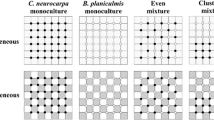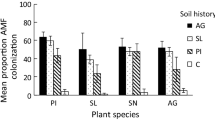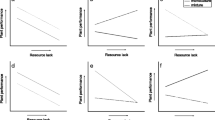Abstract
I studied competition and coexistence of three tall clonal perennial plant species, Calamagrostis epigejos (L.) Roth, Solidago canadensis L., and Tanacetum vulgare L. along a gradient of soil productivity over five years. A replacement series field experiment was conducted with high, moderate and low fertility levels in 1m×1m plots. There were significant effects of soil type on ramet density (P<0.001), mean height (P<0.01), and total biomass (P<0.01). Ramet density, mean height, and total biomass increased with increasing soil fertility. There were also significant effects of mixture on ramet density (P<0.01), but not on mean height and total biomass for all species. Significant neighbor effects on ramet density and total biomass (P<0.01) were found for Solidago, showing that it is important whether Tanacetum or Calamagrostis is its neighbor within mixtures. During the five years there was only one case of competitive exclusion: Calamagrostis excluded Solidago on the most fertile substrate in the fifth growing season. In most cases species coexisted over the five years. Each of the three species was able to dominate in at least one combination of substrate type and mixture. The experiment showed that asymmetric competition for light on substrates of high fertility, symmetric competition for nutrients on nutrient-poor soil and positive interactions especially on substrates of intermediate fertility played a role. A founder effect was evident in aggregated mixtures of Calamagrostis and Solidago on the nutrient-rich substrate. A conceptual model of the relative importance of root competition for soil nutrients, shoot competition for light, and positive interactions along the fertility gradient is presented. The model emphasizes that positive interactions play an important role over a broad range of the productivity scale with a peak at intermediate levels of fertility. On the substrate of high productivity shoot competition for light is more important than positive interactions and root competition for soil nutrients as well. The competitive superiority of Calamagrostis on the most productive substrate was evident only in the long run. Rare events like extreme summer drought or selective herbivore pressure caused a switch in dominance in mixtures with Solidago, respectively Tanacetum. The guerrilla growth strategy of Calamagrostis and interference competition through a dense cover of aboveground biomass and litter could further cause competitive exclusion.
Similar content being viewed by others
References
Aarssen, L. W. 1983. Ecological combining ability and competitive combining ability in plants: towards a general evolutionary theory of coexistence in systems of competition. Am. Nat. 122: 707–731.
Aarssen, L. W. 1988. 'Pecking order' of four plant species from pastures of different ages. Oikos 51: 3–12.
Aiken, S. G., Lefkovitch, L. P. & Armstrong, K. C. 1989. Calamagrostis epigejos (Poaceae) in North America, especially Ontario. Can. J. Bot. 67: 3205–3218.
Belcher, J. W., Keddy, P. A. & Twolan-Strutt, L. 1995. Root and shoot competition intensity along a soil depth gradient. J. Ecol. 83: 673–682.
Bergh, J. P. van den 1968. An analysis of grasses in mixed and pure stands. Agric. Res. Report 174: 1–71.
Bertness, M. D. & Callaway, R. 1994. Positive interactions in communities. TREE 9: 191–193.
Bertness, M. D. & Leonard, G. H. 1997. The role of positive interactions in communities: lessons from intertidal habitats. Ecology 78: 1976–1989.
Bonser, S. P. & Reader, R. J. 1995. Plant competition and herbivory in relation to vegetation biomass. Ecology 76: 2176–2183.
Braakhekke, W. G. 1980. On coexistence: a causal approach to diversity stability in grassland vegetation. Agricultural Research Report 902. Wageningen, The Netherlands.
Braakhekke, W. G. 1985. The significance of competition for plant diversity. Z. Zool. Syst. Evolutionsforsch. 23: 315–327.
Brooker, R. W. & Callaghan, T. V. 1998. The balance between positive and negative plant interactions and its relationship to environmental gradients: a model. Oikos 81: 196–207.
Cajander, A. K. 1925. Der gegenseitige Kampf in der Pflanzenwelt. Veröff. Geobot. Inst. Rübel 3: 665–675.
Callaway, R.M. 1995. Positive interactions among plants. Bot. Rev. 61: 306–349.
Callaway, R. M. 1997. Positive interactions in plant communities and the individualistic-continuum concept. Oecologia 112: 143–149.
Callaway, R.M. 1998. Are positive interactions species-specific? Oikos 82: 202–207.
Callaway, R. M. & King, L. 1996. Temperature-driven variation in substrate oxygenation and the balance of competition and facilitation. Ecology 77: 1189–1195.
Callaway, R. M. & Walker, L. W. 1997. Competition and facilitation: a synthetic approach to interactions in plant communities. Ecology 78: 1958–1965.
Campbell, B. D. & Grime, J. P. 1992. An experimental test of plant strategy theory. Ecology 1992: 15–29.
Connell, J. H. 1983. On the prevalence and relative importance of interspecific competition: Evidence from field experiments. Am. Nat. 122: 661–696.
Connell, J. H. 1990. Apparent versus "real" competition in plants. Pp. 9–26. In: Grace, J.B. & Tilman, D. (eds), Perspectives on plant competition. Academic Press, San Diego, USA.
Cornelius, R., Faensen-Thiebes, A., Marschner, B. & Weigmann, G. 1997. 'Ballungsraumnahe Waldökosysteme' Berlin: Ergebnisse aus dem Forschungsvorhaben. Pp. 1–36. In: Handbuch der Umweltwissenschaften, chapter V-4.9. Ecomed Verlag, Landsberg/ Lech, Germany.
Cottam, D.A. 1985. Frequency-dependent grazing by slugs and grasshoppers. J. Ecol. 73: 925–933.
Crawley, M. J. 1983. Herbivory: the dynamics of animal-plant interactions. University of California Press, Berkeley, California, USA.
Darwin, C. 1859. The origin of species by means of natural selection. 1st edition. John Murray, London, UK.
Ellenberg, H. (transl. by G.K. Strutt) 1988. Vegetation ecology of Central Europe. Fourth edition. Cambridge University Press, Cambridge.
Foster, B. L. & Gross, K. L. 1998. Species richness in a successional grassland: effects of nitrogen enrichment and plant litter. Ecology 79: 2593–2602.
Fowler, N. 1982. Competition and coexistence in a North Carolina grassland. III. Mixtures of component species. J. Ecol. 70: 77–92.
Fowler, N. 1986. The role of competition in plant communities in arid and semiarid regions. Ann. Rev. Ecol. Syst. 17: 89–110.
Gause, G. F. 1934. The Struggle for Existence. Williams & Wilkins, Baltimore.
Gigon, A. & Ryser, P. 1986. Positive Interaktionen zwischen Pflanzenarten. Veröff. Geobot. Inst. ETH, Stiftung Rübel 87: 372–387.
Goldberg, D. E. & Barton, A. M. 1992. Patterns and consequences of interspecific competition in natural communities: a review of field experiments with plants. Am. Nat. 139: 771–801.
Greenlee, J. T. & Callaway, R. M. 1996. Abiotic stress and the relative importance of interference and facilitation in montane bunchgrass communities in Western Montana. Am. Nat. 148: 386–396.
Grime, J. P. 1973. Competitive Exclusion in Herbaceous Vegetation. Nature 242: 344–347.
Grime, J. P. 1979. Plant strategies and vegetation processes. J. Wiley & Sons, Chichester, UK.
Grubb, P. J. 1977. The maintenance of species-richness in plant communities: the importance of the regeneration niche. Biol. Rev. 52: 107–145.
Grubb, P. J. 1985. Plant populations and vegetation in relation to habitat, disturbance and competition: problems of generalization. Pp. 595–621. In: White, J. (ed.), The population structure of vegetation. Dr W. Junk Publishers, Dordrecht.
Gurevitch, J., Morrow, L. L., Wallace, A. & Walsh, J. S. 1992. A meta-analysis of competition in field experiments. Am. Nat. 140: 539–572.
Hall, R. L. 1974. Analysis of the nature of interference between plants of different species. I. Concepts and extension of de Wit analysis to examine effects. Austr. J. Agric. Res. 25: 739–747.
Harper, J. L. 1963. The nature and consequence of interference amongst plants. Pp. 465–482. In: Proc. 11th International Congress of Genetics. Pergamon Press, London, UK.
Harper, J. L. 1977. Population Biology of Plants. Academic Press, London.
Herben, T. & Krahulec, F. 1990. Competitive hierarchies, reversals of rank order and the de Wit approach: are they compatible? Oikos 58: 254–256.
Holt, R. D. 1977. Predation, apparent competition, and the structure of prey communities. Theor. Pop. Biol. 12: 197–229.
Hutchinson, E. 1961. The paradox of the plankton. Am. Nat. 95: 137–145.
Kadmon, R. 1995. Plant competition along soil moisture gradients: a field experiment with the desert annual Stipa capensis. J. Ecol. 83: 253–262.
Kareiva, P. M. & Bertness, M.D. 1997. Re-examining the role of positive interactions in communities. Ecology 78: 1945.
Keddy, P. A. 1989. Competition. Chapman and Hall, London.
Keddy, P. A. 1990. Competitive hierarchies and centrifugal organization in plant communities. Pp. 265–289. In: Grace, J.B. & Tilman, D. (eds), Perspectives on plant competition. Academic Press, San Diego, USA.
Keddy, P. A. & Shipley, B. 1989. Competitive hierarchies in herbaceous plant communities. Oikos 54: 234–241.
Keddy, P., Twolan-Strutt, L. & Shipley, B. 1997. Experimental evidence that interspecific competitive asymmetry increases with soil productivity. Oikos 80: 253–256.
Kershaw, K. A. & Looney, J. H. H. 1985. Quantitative and dynamic plant ecology. 3rd edition. Edward Arnold, London (cited in Wilson 1990).
Lehmann, C. & Rebele, F. 1994. Zum Potential sexueller Fortpflanzung bei Calamagrostis epigejos (L.) Roth. Verh. Ges. Ökol. 23: 445–450.
Louda, S. M., Keeler, K. H. & Holt, R. D. 1990. Herbivore influences on plant performance and competitive interactions. Pp. 413–444. In: Grace, J. B. & Tilman, D. (eds), Perspectives on plant competition. Academic Press, San Diego, USA.
Mattson, W. J. 1980. Herbivory in relation to plant nitrogen content. Ann. Rev. Ecol. Syst. 11: 119–161.
Newman, E. I. 1973. Competition and diversity in herbaceous vegetation. Nature 244: 310.
Peltzer, D. A., Wilson, S. D. & Gerry, A. K. 1998. Competition intensity along a productivity gradient in a low-diversity grassland. Am. Nat. 151: 465–476.
Rebele, F. 1996a. Calamagrostis epigejos (L.) Roth auf anthropogenen Standorten-ein Ñberblick. Verh. Ges. Ökol. 26: 753–763.
Rebele, F. 1996b. Konkurrenz und Koexistenz bei ausdauernden Ruderalpflanzen. Verlag Dr. Kovac, Hamburg, Germany.
Reynolds, H. L., Hungate, B. A., Chapin III, F. S. & D'Antonio, C. M. 1997. Soil heterogeneity and plant competition in an annual grassland. Ecology 78: 2076–2090.
Schlichting, E., Blume, H.-P. & Stahr, K. 1995. Bodenkundliches Praktikum. 2nd edition. Blackwell Wissenschafts-Verlag, Berlin.
Schmidt, W. 1981. Ñber das Konkurrenzverhalten von Solidago canadensis und Urtica dioica. Verh. Ges. Ökol. 9: 173–188.
Schoener, T. W. 1983. Field experiments on interspecific competition. Am. Nat. 122: 240–285.
Shipley, B. & Keddy, P. A. 1994. Evaluating the evidence for competitive hierarchies in plant communities. Oikos 69: 340–345.
Shmida, A. & Ellner, S. 1984. Coexistence of plant species with similar niches. Vegetatio 58: 29–55.
Silvertown, J. W. 1987. Introduction to plant population ecology, 2nd edition. Longman, Harlow.
Silvertown, J., Holtier, S., Johnson, J. & Dale, P. 1992. Cellular automaton models of interspecific competition for space-the effect of pattern on process. J. Ecol. 80: 527–534.
Sokal, R. R. & Rohlf, F. J. 1981. Biometry, 2nd edition. W.H. Freeman, San Francisco, California.
Tansley, A. G. & Adamson, R. S. 1925. Studies on the vegetation of the English chalk. III. The chalk grasslands of the Hampshire-Sussex border. J. Ecol. 13: 177–223.
Tilman, D. 1982. Resource competition and community structure. Princeton University Press, Princeton, NJ, USA.
Tilman, D. 1985. The resource-ratio hypothesis of plant succession. Am. Nat. 125: 827–852.
Tilman, D. 1987. On the meaning of competition and the mechanisms of competitive superiority. Funct. Ecol. 1: 304–315.
Tilman, D. 1988. Plant Strategies and the Dynamics and Structure of Plant Communities. Princeton University Press, Princeton, NJ, USA.
Tilman, D. 1990. Constraints and tradeoffs: toward a predictive theory of competition and succession. Oikos 58: 3–15.
Tilman, D. & Pacala, S. 1993. The maintenance of species richness in plant communities. Pp. 13–25. In: Ricklefs, R.E. & Schluter, D. (eds), Species diversity in ecological communities. University of Chicago Press, Chicago, Illinois, USA.
Trenbath, B. R. 1974. Biomass productivity of mixtures. Adv. Agron. 26: 177–210.
Twolan-Strutt, L. & Keddy, P.A. 1996. Above-and below-ground competition intensity in two contrasting wetland plant communities. Ecology 77: 259–270.
Weber, E. 1997. Morphological variation of the introduced perennial Solidago canadensis L. sensu lato (Asteraceae) in Europe. Bot. J. Linnean Soc. 123: 197–210.
Weber, E. & Schmid, B. 1993. Das Neophytenproblem. Festschrift Zoller. Dissertationes Botanicae 196: 209–227.
Wedin, D. & Tilman, D. 1993. Competition among grasses along a nitrogen gradient: initial conditions and mechanisms of competition. Ecol. Monog. 63: 199–229.
Weiher, E. & Keddy, P. A. 1995. The assembly of experimental wetland plant communities. Oikos 73: 323–335.
Weiner, J. 1986. How competition for light and nutrients affects size variability in Ipomea tricolor populations. Ecology 67: 1425–1427.
Weiner, J. 1990. Asymmetric Competition in Plant Populations. TREE 5: 360–364.
Welden, C. W. & Slauson, W. L. 1986. The intensity of competition versus its importance: an overlooked distinction and some implications. Quart. Rev. Biol. 61: 23–44.
Werner, P. A., Bradbury, I. K. & Gross, R. S. 1980. The biology of Canadian weeds. 45. Solidago canadensis L. Can. J. Plant Sci. 60: 1393–1409.
Wilson, J. B. 1988. The effect of initial advantage on the course of plant competition. Oikos 51: 19–24.
Wilson, J. B. 1990. Mechanisms of species coexistence: twelve explanations for Hutchinson's' paradox of the plankton': evidence from New Zealand plant communities. New Zealand J. Ecol. 13: 17–42.
Wilson, S. D. & Keddy, P. A. 1986. Species competitive ability and position along a natural stress/disturbance gradient. Ecology 67: 1236–1242.
Wisheu, I. C. & Keddy, P. A. 1992. Competition and centrifugal organization of ecological communities: theory and tests. J. Veg. Sci. 3: 147–156.
Wit, C. T. de. 1960. On competition. Versl. Landbouwk. Onderzoek. No. 66.8:1-82. Pudoc, Wageningen, The Netherlands.
Wit, C. T. de & van den Bergh, J. P. 1965. Competition between herbage plants. The Netherlands J. Agric. Sci. 13: 212–221.
Yodzis, P. 1986. Competition, mortality and community structure. Pp. 480–491. In: Diamond, J. & Case, T.J. (eds), Community Ecology. Harper & Row Publishers, New York.
Author information
Authors and Affiliations
Rights and permissions
About this article
Cite this article
Rebele, F. Competition and coexistence of rhizomatous perennial plants along a nutrient gradient. Plant Ecology 147, 77–94 (2000). https://doi.org/10.1023/A:1009808810378
Issue Date:
DOI: https://doi.org/10.1023/A:1009808810378




